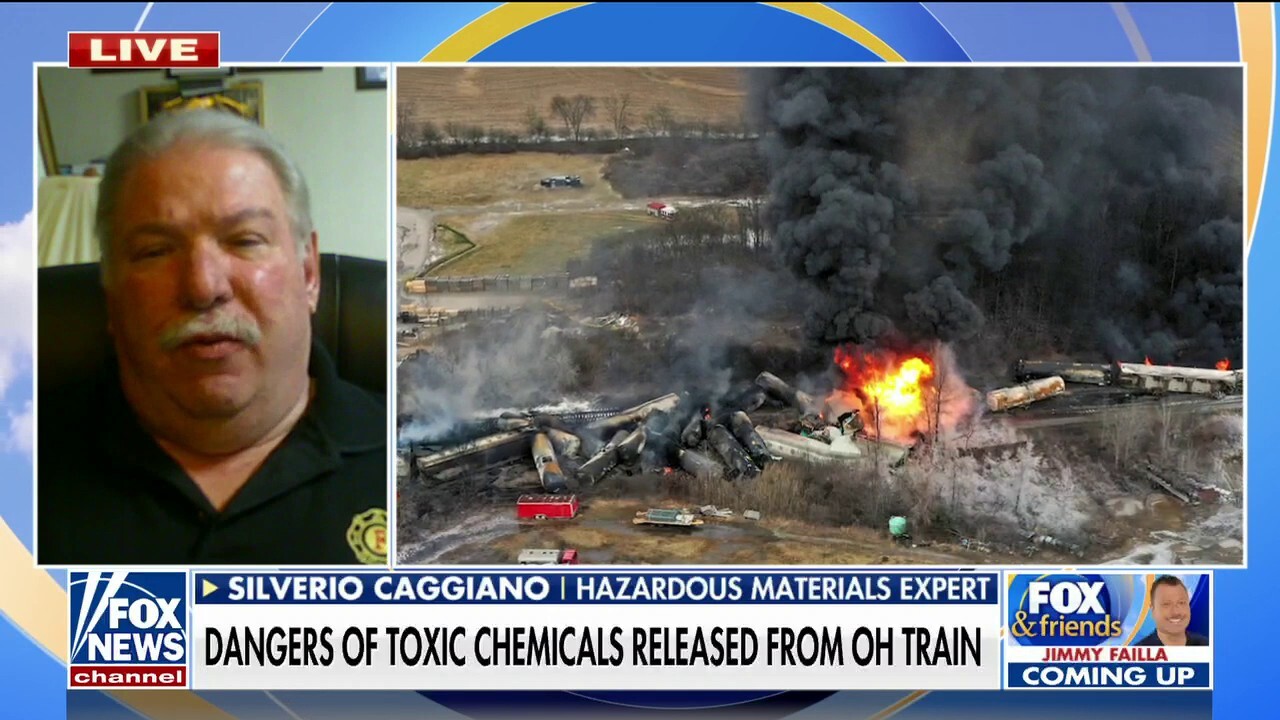Ohio Train Derailment: The Long-Term Impact Of Toxic Chemical Contamination

Table of Contents
Environmental Contamination and its Long-Term Effects
The Ohio train derailment resulted in significant environmental contamination, posing a severe threat to the region's health and ecosystems for years to come.
Soil and Water Contamination
The sheer volume of spilled chemicals, including vinyl chloride, butyl acrylate, and other hazardous substances, has led to widespread soil and water contamination.
- Specific contaminants: Vinyl chloride, a known carcinogen, is a primary concern. Butyl acrylate, ethylhexyl acrylate, and ethylene glycol monobutyl ether are also present and pose significant health and environmental risks.
- Long-term persistence: Many of these chemicals persist in the environment for extended periods, contaminating soil and seeping into groundwater sources. The cleanup process is extensive and complex, with uncertain long-term success.
- Groundwater contamination: The potential for groundwater contamination is a major concern, threatening drinking water supplies for residents and impacting local ecosystems. Thorough testing and monitoring are crucial to assess the full extent of the contamination.
- Impact on agricultural land: The contamination of agricultural land could lead to crop failure, livestock poisoning, and the potential for the entry of toxins into the food chain. This necessitates long-term monitoring of soil quality and the potential need for remediation of affected farmland.
Ongoing monitoring and remediation efforts are underway, but the scale of the contamination presents significant challenges and long-term implications.
Air Quality and its Lasting Impact
The fire ignited after the derailment released a plume of toxic smoke containing various airborne toxins. This created immediate health risks and raises concerns about long-term air quality impacts.
- Health risks: Long-term exposure to even low levels of these toxins can lead to a range of respiratory illnesses, including asthma, bronchitis, and other chronic conditions.
- Potential for respiratory illnesses: The release of vinyl chloride and other irritants poses significant risks for respiratory problems, both short and long-term. This necessitates ongoing air quality monitoring and medical surveillance for affected populations.
- Impacts on wildlife: Airborne toxins can affect wildlife populations, potentially leading to decreased reproductive rates, developmental problems, and increased mortality.
While immediate air quality monitoring data was collected, long-term effects require ongoing studies and vigilant tracking.
Impact on Wildlife and Ecosystems
The ecological damage caused by the Ohio train derailment is substantial and far-reaching.
- Species affected: Fish, amphibians, birds, and other wildlife inhabiting the affected waterways and surrounding areas are highly vulnerable to the toxic chemicals.
- Population decline: Exposure to these chemicals can lead to population declines, disrupting the delicate balance of the local ecosystem. Bioaccumulation of toxins in the food chain further exacerbates this threat.
- Disruption of food chains: The contamination of water and food sources can significantly disrupt the food chain, with cascading effects on various species.
- Long-term ecological consequences: The long-term consequences of this ecological damage could be significant, impacting biodiversity and the overall health of the ecosystem for decades to come.
Human Health Consequences: Present and Future
The health consequences of the Ohio train derailment extend beyond the immediate aftermath.
Immediate Health Impacts
Residents reported a range of immediate health issues following the derailment:
- Reported illnesses: Headaches, nausea, vomiting, respiratory problems, skin irritation, and eye irritation were among the symptoms reported by residents.
- Number of individuals affected: Precise numbers are difficult to ascertain, but reports indicate a significant number of individuals experienced health problems.
- Immediate medical responses: Local hospitals and healthcare providers responded to the influx of patients experiencing these symptoms.
Long-Term Health Risks
Long-term exposure to the released chemicals carries a significant risk of serious health problems:
- Cancer risk: Vinyl chloride is a known human carcinogen, increasing the risk of various cancers. Long-term monitoring will be necessary to track the incidence of cancer in the affected population.
- Reproductive issues: Exposure to certain chemicals can negatively affect reproductive health, potentially impacting fertility and increasing the risk of birth defects.
- Developmental problems: Exposure during pregnancy can lead to developmental problems in children.
- Chronic illnesses: Many of the released chemicals can contribute to chronic illnesses, including respiratory and cardiovascular diseases.
The need for long-term health monitoring of the affected population is paramount.
Psychological Impact
Beyond physical health, the derailment has created a significant psychological burden on the community:
- Stress and anxiety: Residents are experiencing considerable stress and anxiety related to their health, the environment, and the uncertainty of the long-term consequences.
- Fear of long-term health consequences: The unknown long-term health effects of exposure are a source of immense fear and anxiety.
- Community disruption: The event has disrupted daily life, social connections, and the sense of community safety.
Legal and Political Ramifications
The Ohio train derailment has significant legal and political ramifications.
Accountability and Responsibility
The incident has ignited numerous legal battles and political controversies:
- Investigations into the cause: Investigations are underway to determine the root cause of the derailment and assign accountability.
- Lawsuits against Norfolk Southern: Numerous lawsuits have been filed against Norfolk Southern, seeking compensation for damages and holding the company accountable for its negligence.
- Government response and regulatory scrutiny: The government's response and the level of regulatory oversight have come under intense scrutiny.
Future Regulations and Safety Measures
This disaster has spurred calls for significant changes in the regulation and transportation of hazardous materials:
- Improved safety protocols: Enhanced safety protocols for transporting hazardous materials are needed to prevent future derailments.
- Stricter regulations: Increased scrutiny of railway safety practices and stricter regulations are essential.
- Increased oversight: More robust oversight of the transportation of hazardous materials is crucial to minimize risks.
Conclusion
The Ohio train derailment and its resulting toxic chemical contamination represent a multifaceted crisis with far-reaching consequences. The long-term impacts on the environment, human health, and the political landscape are profound and require sustained attention. The ongoing monitoring of soil and water quality, air quality, and the health of residents is crucial. The legal battles and the resulting changes in regulations will shape the future of hazardous materials transportation.
Understanding the long-term impact of the Ohio train derailment and its toxic chemical contamination is crucial for demanding accountability and preventing future tragedies. Stay informed, support affected communities, and demand stronger safety regulations. We must learn from this disaster to ensure that such a catastrophic event is never repeated.

Featured Posts
-
 Are Stock Investors Prepared For More Market Downturns
Apr 22, 2025
Are Stock Investors Prepared For More Market Downturns
Apr 22, 2025 -
 Googles Search Monopoly Doj Returns To Court
Apr 22, 2025
Googles Search Monopoly Doj Returns To Court
Apr 22, 2025 -
 Stock Market Today Dow Futures Fall Dollar Weakens Amid Trade Tensions
Apr 22, 2025
Stock Market Today Dow Futures Fall Dollar Weakens Amid Trade Tensions
Apr 22, 2025 -
 Comparing Blue Origins Setbacks To Katy Perrys Career Challenges A Case Study
Apr 22, 2025
Comparing Blue Origins Setbacks To Katy Perrys Career Challenges A Case Study
Apr 22, 2025 -
 Pandemic Fraud Lab Owners Guilty Plea On False Covid Tests
Apr 22, 2025
Pandemic Fraud Lab Owners Guilty Plea On False Covid Tests
Apr 22, 2025
